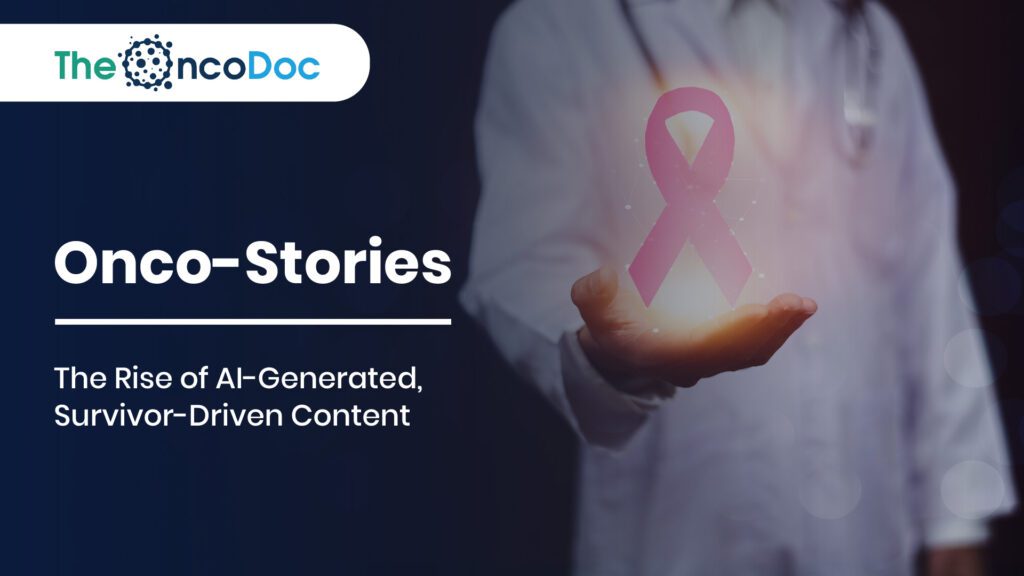Introduction: A Paradigm Shift in Oncology Pharma Marketing
Oncology marketing is entering a new storytelling era, where patient voices are not only central but also dynamically shaped by artificial intelligence. Traditional, one-size-fits-all patient testimonials are being replaced with deeply personalized “onco-stories”, AI-generated survivor-driven narratives designed to resonate with diverse audiences. In this model, storytelling goes beyond inspiration; it becomes a powerful clinical and emotional engagement tool.
AI’s ability to analyze data from health records, emotional sentiment, social media, and survivor interviews allows pharma marketers to craft tailored campaigns that empower patients, educate caregivers, and humanize cancer therapies. These strategies bring authenticity, precision, and cultural relevance to oncology communication.
This article explores key strategies and innovations driving this transformation, combining survivor authenticity with AI’s analytical power.
1. The Problem with Traditional Storytelling Models
Static survivor testimonials that were recorded in booklets, pamphlets, or a single film were a major component of traditional oncology marketing. These stories lacked nuance and often failed to connect with diverse patient demographics.
Key drawbacks include:
- Limited Relevance: A breast cancer survivor’s story may not resonate with a lung or colon cancer patient.
- Therapy Disconnect: Stories tied to one treatment journey can alienate patients on different regimens.
- Cultural Gaps: Stories often ignored linguistic and cultural diversity, reducing relatability.
- Inflexibility: Printed or pre-recorded content cannot adapt to different patient needs or emotional states.
This model underdelivered on empathy and personalization, especially as patients increasingly expect tailored, data-driven healthcare experiences.
2. The Birth of AI-Powered “Onco-Stories”
AI transforms storytelling by making it dynamic, hyper-personalized, and emotion-driven. Instead of producing a single generic survivor video, pharma brands can now generate hundreds of story variations, each tailored to specific cancer types, geographies, and treatment contexts.
For example:
- A young breast cancer survivor’s journey is customized into narratives for rural and urban audiences.
- AI-generated subtitles in local languages ensure accessibility.
- Emotional tones (hopeful, empathetic, or encouraging) are adjusted based on the patient’s treatment stage.
These AI-driven campaigns create deeper emotional resonance, improving engagement and trust.
3. Survivor Voices at the Heart of AI Storytelling
AI technology doesn’t replace survivor voices, it amplifies them. Survivor interviews, blogs, and videos form the foundation of these campaigns, while AI enhances distribution and personalization.
- Survivors’ unique phrases, cultural references, and imagery are preserved to maintain authenticity.
- AI-powered analytics identify which survivor stories evoke the strongest emotional and behavioral responses.
- This method promotes authenticity by transforming survivors from passive recipients of content into active co-creators.
4. Emotional Intelligence in Storytelling
AI tools now include emotional intelligence features that analyze tone, body language, and facial expressions from survivor recordings to create emotionally optimized campaigns.
- Narratives with an emphasis on empathy are more likely to promote screening participation.
- AI helps detect subtle emotional cues (e.g., hope, resilience, anxiety) and integrates them into campaigns.
- The result: survivor stories that feel personal, not programmed.
5. Personalization at Scale
Pharma brands can leverage AI to generate thousands of unique story variations based on:
- Cancer type: Tailored content for breast, lung, colon, and rare cancers.
- Geography: Hyperlocal campaigns that reflect cultural values and language.
- Treatment stage: Stories designed for pre-diagnosis awareness, active treatment encouragement, or survivorship support.
This personalization improves message relevance and fosters trust, reducing emotional isolation among patients.

6. Barriers Overcome by AI-Driven Storytelling
AI-generated onco-stories address significant challenges in traditional campaigns:
- Scalability: Automated tools create diverse narratives quickly.
- Inclusivity: Stories can be instantly adapted for multiple demographics.
- Cost Efficiency: AI lowers the cost of producing regional and multilingual content.
- Real-Time Updates: Survivor stories can evolve based on ongoing treatment or new cancer research.
7. Data-Driven Story Insights
Every AI-driven survivor story campaign is backed by behavioral and clinical data analytics. AI analyzes click-through rates, emotional sentiment, dwell time on videos, and demographic responses to optimize messaging.
This data-driven storytelling ensures that narratives not only resonate emotionally but also influence patient outcomes, like early screenings and adherence to treatment plans.

8. Survivor Clubs as Story Incubators
Survivor networks are becoming storytelling powerhouses. Pharma companies support survivor groups in order to collect real stories and create a feeling of community. These clubs are also:
- Co-creating campaigns by curating raw survivor stories.
- Organizing workshops on emotional wellbeing related to pharmaceutical programs.
- Encouraging survivors to become advocates and educators.
9. Ethical AI in Survivor Storytelling
As AI takes a leading role in storytelling, ethics are critical. Pharma companies must:
- Obtain explicit consent from survivors.
- Keep information on how AI uses survivor inputs transparent.
- Avoid emotional manipulation while keeping stories inspiring.
· It’s critical to give survivors creative credit for their contributions.
10. AI-Powered Micro-Targeting
By leveraging AI’s predictive analytics, pharma brands can identify populations at risk and deliver highly relevant stories:
- A spike in searches for “persistent cough” in a district triggers lung cancer survivor campaigns.
- Preventive screenings are emphasized in breast cancer survivor stories for urban women between the ages of 30 and 45.
This micro-targeting ensures campaigns reach the right people at the right time.
11. AI Voiceovers and Dynamic Video Personalization
Voice-cloning AI can convert survivor stories into multilingual campaigns, ensuring accessibility. AI also creates dynamic videos that adapt based on viewer data, including:
- Patient age.
- Geographic location.
- Preferred communication channel (mobile, WhatsApp, YouTube).
This technology enables storytelling that feels intimate and direct.
12. Social Media Storytelling 2.0
Stories driven by AI flourish on sites like YouTube, Instagram, and TikTok. Strategies include:
- Interactive story polls featuring survivor quotes.
- Real-time AI captions for accessibility.
- Geo-tagged survivor content for regional campaigns.
The rise of short-form survivor content ensures broad reach and high engagement.
13. Integration with Digital Health Tools
Onco-stories aren’t standalone assets, they’re integrated into digital health ecosystems:
- Patient support apps feature survivor-led video diaries.
- Chatbots recommend survivor content based on user symptoms or questions.
- Wearables prompt patients with motivational survivor clips when health metrics show irregularities.
This creates a continuous narrative ecosystem for patients.
14. AI Storytelling as Emotional Therapy
For many patients, survivor stories aren’t just inspirational, they’re therapeutic.
AI-driven personalization means stories can be emotionally tuned to support different mental health states:
- Hope-driven content for newly diagnosed patients.
- Resilience narratives for those undergoing aggressive treatments.
- Encouragement stories for survivors navigating life post-treatment.

15. Hyperlocal Language Models for Storytelling
AI-powered language models help craft survivor stories in regional dialects. Campaigns in India now feature:
- Tamil-language stories for breast cancer awareness.
- Assamese survivor interviews for oral cancer campaigns.
- Bhojpuri content for rural Bihar screening drives.
Local language personalization boosts engagement and inclusivity.
16. Survivor Stories in AR/VR Campaigns
AR/VR technology is revolutionizing oncology storytelling by transforming survivor narratives into immersive learning experiences:
- Virtual Reality (VR) “walkthroughs” of survivor journeys guide patients through treatment stages, offering clarity and emotional reassurance during their care journey.
- Augmented Reality (AR) campaigns in diagnostic centers create interactive, real-time experiences that reduce patient anxiety and improve engagement.
These innovations allow caregivers, patients, and oncologists to better understand complex cancer treatments while fostering empathy and trust. By merging survivor authenticity with cutting-edge technology, pharma brands deliver impactful education that empowers patients, encourages participation, and enhances the overall oncology experience.
17. Gamified Storytelling for Screening Drives
Gamification is transforming oncology awareness by integrating survivor narratives into interactive, engaging experiences:
- Educational quizzes featuring survivor tips on early detection encourage participation while boosting knowledge retention.
- Community leaderboards track screening participation, inspiring friendly competition and collective action toward cancer prevention.
- Rewards and incentives, such as digital badges or recognition, are offered for watching, sharing, or engaging with survivor-led campaigns.
This innovative approach makes cancer education more approachable and memorable, motivating individuals and communities to take proactive steps toward screening. Gamified narratives have a quantifiable influence on early detection efforts by fusing survivor authenticity with playful involvement.
18. Collaboration Between Pharma, NGOs, and Survivors
Collaborative efforts between pharma companies, NGOs, and survivors are revolutionizing oncology storytelling and outreach:
- NGOs play a crucial role in identifying and sourcing authentic survivor voices, ensuring campaigns are grounded in real experiences.
- Pharma brands provide advanced AI-driven storytelling infrastructure to scale narratives, optimize messaging, and deliver content with precision.
- Survivors lead grassroots awareness drives, particularly in underserved rural regions, fostering trust and cultural relevance.
This powerful collaboration creates campaigns that are emotionally resonant, widely accessible, and deeply credible, strengthening patient engagement and improving cancer education. It reflects a united approach where technology, authenticity, and advocacy drive meaningful impact.
19. Survivor Content as an Advocacy Tool
AI-powered amplification transforms survivor stories into influential advocacy tools that drive meaningful change:
- Survivor-led campaigns elevate authentic voices, influencing healthcare policy decisions and securing increased funding for cancer research and patient support programs.
- Social media advocacy from survivors builds credibility and public trust faster than traditional pharma marketing efforts, fostering genuine connections with audiences.
- Survivor ambassadors play a vital role in normalizing cancer conversations, breaking stigma, and encouraging early detection.
This strategic integration of survivor narratives not only strengthens brand authenticity but also empowers patients, creating a collaborative ecosystem where survivors lead impactful, trust-driven oncology awareness initiatives.
20. Emotional Sentiment Analysis for Campaign Feedback
AI-driven sentiment analysis evaluates audience reactions across comments, likes, shares, and reviews to understand emotional impact and campaign effectiveness:
- Insights guide adjustments to storytelling tones, reducing fear and promoting positivity, empathy, and trust.
- Analysis identifies cultural or linguistic gaps, ensuring campaigns resonate with diverse patient populations.
- Pharma brands refine narrative strategies based on real-time data, creating content that is both impactful and emotionally relevant.
This feedback-driven approach enables oncology marketing teams to deliver campaigns that not only educate but also connect with patients on a deeper emotional level, fostering engagement and long-term brand trust.
21. Stories as Preventive Care Drivers
Measurable behavior change is produced by preventive screening programs that are based on survivor stories:
- Personalized survivor stories increase mammogram participation rates.
- Campaigns featuring male survivors help destigmatize cancers affecting men.
- Survivor voices enhance trust in screening initiatives.
22. Building Survivor Content Libraries
Pharma companies are creating AI-curated content libraries featuring diverse survivor stories categorized by:
- Cancer type.
- Geographic region.
- Language and cultural relevance.
- Emotional tone (hopeful, motivational, clinical).
This library becomes a permanent educational resource for oncology awareness.
23. Predictive Storytelling
AI-powered predictive storytelling enables oncology marketers to stay ahead of audience needs by leveraging data-driven foresight:
- AI analyzes engagement data to pinpoint which survivor narratives will resonate most with evolving cancer demographics and awareness trends.
- Campaign performance is forecasted using historical metrics, ensuring better resource allocation and improved reach.
- Proactive storytelling strategies are developed in anticipation of potential health crises or disease surges, enabling timely, targeted messaging.
This forward-looking approach transforms storytelling into a strategic tool, empowering pharma brands to deliver highly relevant content, strengthen trust, and support early detection efforts while staying agile in a rapidly changing healthcare landscape.
24. Ethical Story Curation Guidelines
Pharma companies are adopting rigorous ethical frameworks to safeguard cancer survivors and ensure responsible storytelling:
- All survivor stories undergo thorough review for accuracy, sensitivity, and cultural appropriateness before publication.
- Patients retain full autonomy, with the right to revoke consent at any stage of the campaign.
- Survivor contributions are recognized with clear credit, and many brands provide financial or non-monetary compensation for their participation.
These measures build trust, protect survivor dignity, and demonstrate a commitment to transparency, ensuring that AI-driven oncology storytelling remains respectful, authentic, and patient-centric while aligning with industry regulations and ethical marketing practices.
25. Future of Onco-Stories in Oncology Pharma Marketing
By 2030, AI-driven survivor storytelling will evolve into personalized narrative ecosystems, where each patient experiences cancer education through stories that mirror their journey. The combination of survivor authenticity and AI precision will:
- Increase early cancer detection rates.
- Humanize pharma brands.
- Transform cancer awareness into an emotional, data-driven movement.
Conclusion
AI-generated, survivor-driven storytelling is not just a marketing tactic, it is a paradigm shift in oncology communication. By combining empathy, authenticity, and precision, pharma brands can create impactful campaigns that educate, inspire, and empower. As AI becomes more advanced, stories will continue to evolve into personalized, dynamic experiences, making oncology marketing more compassionate, inclusive, and effective than ever before.
The Oncodoc team is a group of passionate healthcare and marketing professionals dedicated to delivering accurate, engaging, and impactful content. With expertise across medical research, digital strategy, and clinical communication, the team focuses on empowering healthcare professionals and patients alike. Through evidence-based insights and innovative storytelling, Hidoc aims to bridge the gap between medicine and digital engagement, promoting wellness and informed decision-making.



